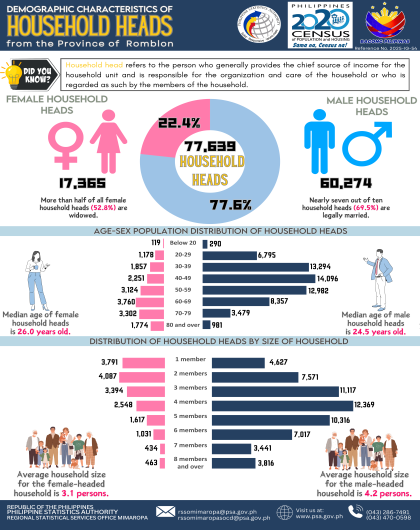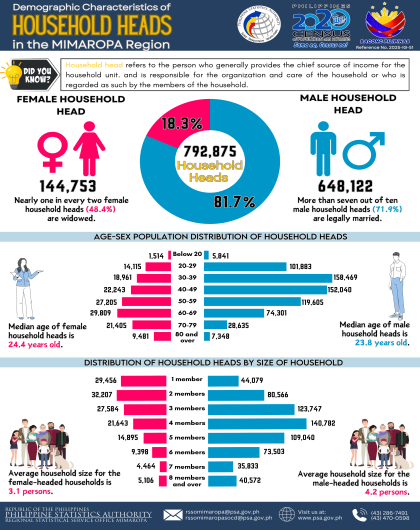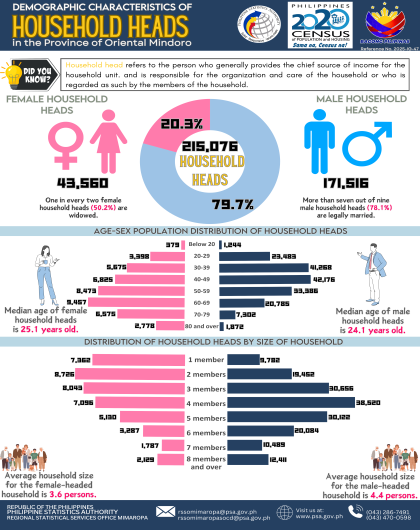One in every 1,000 residents in MIMAROPA is a foreign citizen
In 2020, about 3,209,391 or 99.9 percent of the 3,212,287 household population in the MIMAROPA Region are Filipino citizens. Filipinos with dual citizenship, on the other hand, reached 1,251 persons, with less than 0.1 percent. Foreign citizens totaled to 1,645 persons or 0.1 percent of the household population in the Philippines. (Table 1)
More than two in every MIMAROPAns with dual citizenship reside in Oriental Mindoro
In 2020, 42.0 percent of Filipinos in MIMAROPA with dual citizenship were residing in Oriental Mindoro. Those who resided in Romblon and Palawan excluding the City of Puerto Princesa had a respective share of 13.8 percent and 13.7 percent, respectively. Meanwhile, the province of Marinduque had the least number of Filipinos with dual citizenship. Occidental Mindoro closely followed with its total Filipinos.
Meanwhile, nearly one in every five or 18.5 percent of Filipinos with dual citizenship found in the MIMAROPA Region have been living in the City of Puerto Princesa.
Nearly one in every three MIMAROPAns with dual citizenship is a Filipino-American
Of the 1,251 Filipinos with dual citizenship that resides in the MIMAROPA Region, about 32.9 percent were Filipino-Americans with 411 persons. Filipino-Germans totaled to 128 persons (10.2%) while Filipino-Canadians reached 106 persons (8.5%). (Table 2)
More than seven in every 20 foreigners in the MIMAROPA Region reside in Oriental Mindoro
Of the total of 1,645 foreign citizens residing in the MIMAROPA Region at the time of the census in 2020, about 36.7 percent resided in the Oriental Mindoro. Those who resided in Palawan except in the City of Puerto Princesa made up 17.2 percent, followed by those who resided in Central Romblon, with 10.6 percent.
Meanwhile, 457 foreigners have been living in the City of Puerto Princesa. This comprises to 27.8 percent share to the number of foreigners in the region. (Figure 2)
More than one in every eight foreigners in the region come from the United States of America
The highest number of foreign citizens in the region came from the United States of America with 207 persons (12.6%). It was followed by foreign citizens from the People’s Republic of China with 200 persons (12.2%). Completing the top five countries of and Germany with 160 persons (9.7%). (Table 3)
TECHNICAL NOTES
I. Introduction
The Philippine Statistics Authority conducted the 2020 Census of Population and Housing (2020 CPH) in September 2020, with 01 May 2020 as reference date.
The 2020 CPH was the 15th census of population and 7th census of housing that was undertaken in the Philippines since the first census in 1903. It was designed to take inventory of the total population and housing units in the country and collect information about their characteristics.
The Philippine Standard Geographic Codes as of March 2022 was used for the disaggregation of geographic levels of the 2020 CPH.
II. Data Collection
Data on citizenship allows the classification of the population into: (a) citizens and (b) aliens. These data are valuable in the study of problems relating to the legal status and civil rights of immigrants.
The list of countries that does not allow dual citizenship are provided by the Department of Foreign Affairs.
The statistics presented in this report were based on the information provided by the respondent or any responsible household member who may provide accurate answers to the questions and give correct information about all the household members; hence, it should be used with caution.
III. Methodology
The population and housing censuses in the Philippines are conducted on a “de jure” basis, wherein a person is counted in the usual place of residence or the place where the person usually resides. The enumeration of the population and collection of pertinent data in the 2020 CPH referred to all living persons as of 01 May 2020.
For the 2020 CPH, data on the citizenship of all household members were collected by asking the respondents, “Is _____ a citizen of the Philippines?” This question determines who among the members of the household are citizens of the Philippines and who are not. For Filipino dual citizens and non-citizens, the question “What country/other country is _______ a citizen of?” was asked. This question determines who among the members of the household is a citizen of a foreign country.
IV. Concepts and Definition of Terms
A household is a social unit consisting of a person living alone or a group of persons who sleep in the same housing unit and have a common arrangement in the preparation and consumption of food.
Household population comprises of persons who belong to a household.
Citizenship is defined as the legal nationality of a person. A person’s citizenship depends on the country to which he/she owes legal allegiance or where he/she exercises the right of suffrage.
Filipino Dual Citizens is classified as Natural-born Filipinos who are simultaneously citizens of the Philippines and another country.






